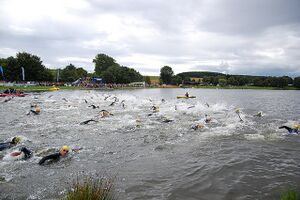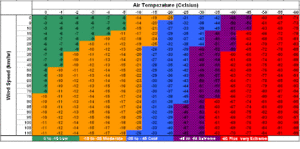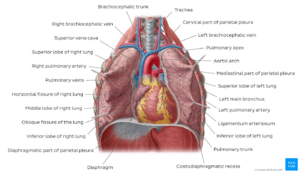Cold Acclimation and the Effect on Sport Performance
Original Editor - Kapil Narale
Top Contributors - Kapil Narale
Introduction[edit | edit source]
In an extreme cold environment, even though behavioural or psychological adaptations may act to maintain a sufficient amount of body heat, it is possible that core or peripheral skin temperature can be decreased to a point where metabolic and physiologic functions are no longer sufficient and damage to skin and other tissues may occur. [1]
Environmental cooling power is not only determined by the ambient wet bulb temperature, but is also influenced by the wind and wet clothing. The wind can produce heat loss through convection, while wet clothing increases heat loss through evaporation. Water temperature and currents, with water activities, can contribute to a cooling effect. Inhalation of cold air can also have negative effects for asthmatic healthy athletes. [1]
Physiology of Exercising in the Cold[edit | edit source]
Please see the various sections of the Thermoregulation and Exercise in the Heat and Cold page for more information:
- Cold Acclimation
- Factors Affecting Body Heat Loss
- Physiological Response to Exercise in the Cold
- Health Consequences of Cold
See Cold Related Injuries for further explanation of the below definitions
Various Environmental Conditions[edit | edit source]
Hypothermia and Sport[edit | edit source]
In sporting events like the Winter Olympics, there can be a vast range in cold temperature, ranging from <-5oC and >+5oC. The production of metabolic heat during exercise surpasses the rate of body heat loss in similar and colder environments. In winter sports which involve displacement in a straight line, such as Alpine skiing or snowboarding, factors such as wind and low air-temperature, at high athlete movement speeds, expose the athletes to even apparent colder conditions. However, the production of metabolic heat is quite high during such an activity. In fact, athletes who are participating in events that last around 2 hours, such as Nordic skiing, have a metabolic heat production that is even higher, about 13-18 METS. With this kind of metabolic heat production, the loss of body heat is dissipated, decreasing the chance of suffering experiencing hypothermia during the activity in the respective cold conditions. [1]
Open Water Swimming[edit | edit source]
When considering open body water temperature in swimming events, even in the summer, there is a minimum lower limit for the water temperature. Body heat loss with water immersion can be much greater than that lost in air of the same temperature, making hypothermia more likely. The lower limit of water temperature is 16oC. Cold water for swimming usually ranges from 10oC to 15oC. [2] If the temperature of the water, 1m below the surface, is below the 16oC limit, an open water swimming event will not proceed. Thermoregulatory modelling helps indicate that open water swimmers, swimming at race speeds, in water ≥16oC, will not experience a significant reduction in body temperatures. However, a group of athletes suggest that the 16oC limit may not be high enough. [1] However, in the UK, British Triathlon has a guideline that at temperatures below 11oC, open water swimming should not take place. It also notes that the minimum temperatures at which wetsuits are optional is at 14oC. With these temperatures listed, the maximum allowable swimming distance is, 11oC for 500m, 12oC for 1000m, and 13oC for 2000m. [2]
The cold water could also be causing an arrhythmogenic effect. When the actions of exposure to cold water, holding your breath, and immersion of your face, can cause increased sympathetic and parasympathetic activity, which could lead to premature ventricular contractions, thus could cause fatal outcomes. [1] This may occur regardless of optimal health of competitive athletes. [2]
It is seen that thee can be a very slim difference between categorising what is 'safe' and 'unsafe' when considering the limit temperatures of open-water swimming, especially when there can be multiple confounding factors. Some of these factors include water temperature, production of metabolic heat, and the amount of insulation of the swimmer's clothing. More specific factors could be skill level of swimming, body composition, fitting of the 'wet suit', and any acute asymptomatic heat infection or the degree of radiation heat experienced. It is possible, as mentioned by the USA Triathlon Fatality Incidents Study that death can commonly occur due to cardiac death, rather than hypothermia. Therefore, reducing the cause of death in open water swimming should be considered beyond cold water exposure. [2]
Cold water immersion could have life threatening effects such as, drowning, cardiac problems, hypothermia, and cardiovascular problems due to a decreased circulating blood volume when leaving the water. The reduced circulating blood volume is caused by the hydrostatic pressure causing a squeeze, and the cold-induced vasoconstriction, which causes a diuresis during immersion. This can jeopardise the preserving of an arterial blood pressure when exiting the water and moving into an upright position, which elicits the loss of hydrostatic pressure, and orthostatic stress. This issue may be exacerbated with the removal of the tight-fitting wet-suit upon exiting the water. [2]
It is seen that a water temperature of below 25oC is lower than the point where exercise will speed up the rate of deep body temperature cooling, compared to when stationary. The temperature that individuals, in a swimsuit, can maintain thermal homeostasis, is unclear, which may be due to work intensity or body composition. [2]
With the immersion into cold water, there is an initial cold shock response, a gasp response, uncontrollable hyperventilation, tachycardia, and a greater level of circulating stress hormones. The response is facilitated by the dynamic action of the cold receptors, which peaks in the first 30sec of immersion in cold water and adapts over a period of 2 minutes. As mentioned, drowning may occur, which can be a result of the loss of control of breathing. In fact, it is seen that most of the deaths commonly occur during competition rather than during training or practicing in open water. The reasons are somewhat unknown. It is shown that facilitation of the sympathetic and parasympathetic receptors at the heart can cause cardiac arrhythmias. Individuals with predisposing conditions, can result with fatal arrhythmias. It is more likely to occur during competition since there are longer periods of breath holding, aspiration of water into the nasopharynx, and the feelings of increased anger or exasperation. [2]
The feeling of anger or exasperation can easily lead to ventricular fibrillation. This type of emotion heightens sympathetic tone, while keeping parasympathetic tone in balance. [2]
With the prolonged exposure to cold water, and the exposure to extremely cold water, there are significant and detrimental effects of physiological functions. This can deteriorate bodily functions needed for swimming, in beginners or competitors, the beginners being more affected due to less experience with swimming and poorer acclimatisation. [2]
In colder environments compared to environments with a neutral temperature, there is a higher oxygen consumption during exercise of roughly 2.0L/min. It is seen that the increase in oxygen consumption is greater in more fit individuals. [2]
Subsequent to a cold water swim, the deep body temperature will likely continue to decline because of the thermal gradient that was created during the swim. These athletes would thus need to be monitored for changes in body temperature, especially as they go from swimming to biking, in a triathlon, on a cold and wet day, or are leaving from their swimming race. [2]
Frostbite and Sport[edit | edit source]
When the skin temperature drops below 0oC, frostbite can occur. The risk of frostbite is seen to increase with wind, which increases convective heat loss at areas of exposed skin. This accounts for the windchill factor, which can be understood by analyzing the windchill chart seen on pg. 773 (of the PDF; or in the Effects of Cold Exposure on Health and Performance of High-Level Athletes section of the article online) of Bergeron et al (2012). Similar to the wind that contributes to a greater difference between air temperature and metabolic heat production, activities such as running or skiing would result in wind being produced across the body, resulting in a greater windchill factor. When the windchill temperature is below -27oC, any exposed skin can experience frostbite within 30 minutes. [1]
There are examples of different athletes that are at a risk of developing frostbite: [1]
- Nordic skiers and biathletes can travel at speeds of 24-27km/h. At this wind speed, there is a risk of frostbite since it is likely that air temperatures are below -20oC.
- Alpine skiing and sliding activities have athletes ttravelling at speeds of up to 60-100km/h. At this wind speed, there can be a risk of an athlete experiencing a frostbite at an air temperature of -15oC.
However, each session of these activities are completed within 3 minutes, so it is unlikely for a frostbite to occur. [1]
Since this is only a risk to exposed skin, windproof clothing would help mitigate the risk of frostbite. It is seen that the athletes have a much lower risk when they are in motion, but while stationary, and for other individuals such as staff and coaches, who are more or less stationary and don't have a high metabolic heat production, there could be a high risk of frostbite. [1]
Cold Exposure and Cardiorespiratory Problems in Athletes[edit | edit source]
Exposure to the cold produces two major physiological changes to the body, increased thermogenesis and peripheral vasoconstriction. A high level of sympathoadrenal activity is stimulated with exposure to the cold, which elicit catecholamine and cortisol secretions. Exercise in the cold can have an effect on immune function, since shivering induced muscle contractions are similar to contractions during a bout of exercise. these effects can result from physiologic changes in blood flow distribution, plasma volume, and cardiac output. Throughout many studies, it is see that trained athletes have an enhanced tolerance to the cold, and an increased thermoregulatory sensitivity. [3]
It is seen that ≥50% of elite cross-country skiers and swimmers may experience Exercise-Induced Asthma (EIA), and Bronchial Hyper-Responsiveness (BHR). EIA is seen to be caused by heat loss and water loss from respiration. The inhalation of cold air steeply increases the magnitude of exercise-induced bronchoconstriction (EIB), thus decreasing athletic performance. Regardless of inhaling warm air, cold fascial temperatures can increase EIB, thus causing a parasympathetic nervous reflex. [1]
There is a high prevalence of asthma in athletes with exposure to cold air who are participating in endurance sports such as cross-country skiing, Nordic skiing, biathlon, and speed skating. This may occur due to epithelial damage of the respiratory mucosa. Inflammation of the airway, which is denoted by percentage of neutrophils in induced sputum, is associated to the number of hours per week spent on training for cross-country skiers and swimmers. However, age and number of competitive years in cross-country skiers is correlated with intensity of BHR. As seen in bronchial biopsies in young skiers, with or without asthma, there was a significant increase in airway inflammation in competitive cross-country skiers over the winter season. There was a noted increased parasympathetic activity in athletes with a positive metacholine BHR compared to a negative metacholine BHR, who presented with decreased excretion of sweat, production of saliva, and flow of tears. The protection against EIB by inhaled ipratropium bromide in cross-country runners exercising at cold temperatures was marked by greater parasympathetic (vagal) activity. [1]
Many of these respiratory conditions are primarily caused by respiratory epithelial damage in endurance athletes. There is an increase in airway inflammation with the increased exposure to the cold. It is seen that epithelial bronchial culture cells from asthmatics have a slower healing process subsequent to scarring. Though the healing can be accelerated by adding steroids to a cell culture. [1]
There is not much evidence which indicates that alterations brought by the immersion in cold water impaires respiratory function to an extent that disturbs oxygen uptake during exercise. [2]
Swimmers partaking in cold water swimming can experience acute pulmonary oedema and hemoptysis. With exposure to cold water, the cutaneous vasoconstriction that occurs may increase venous return, thus leading to an increased blood pressure and central vascular volume. This effect is similar to swimming-induced or immersion-related pulmonary congestion. [1]
Once the cold shock response has diminished, resting, submaximal, and maximal heart rates are reduced, when compared to the immersion in warm water. Cardiac Output is maintained with an increased stroke volume. [2]
A cold induced diuresis, which can reduce circulating plasma by 24%, can be caused by peripheral vasoconstriction and hydrostatic pressure, which occurs from the central redistribution of blood upon entering cold water. As a result, this can have a negative effect on muscle perfusion and present with problems upon exiting the water. [2]
Acclimation[edit | edit source]
Cold acclimation may restrain from training adaptations as it reduces sympathetic responses to the cold, and thus decreases the rate of glycogenesis and lipolysis, and enhances vasoconstriction. The improvements in cold tolerance can be elicited due to the increased stimulation of the immune system. [3]
There are a very few effects of cold acclimation, and in fact it doesn't really provide any benefit for maintaining normal body temperature or avoiding cold injury. [1]
It is noted that that individuals who participate in open water swimming experience health benefits such as an enhanced immunity and an increased alertness. It is seen that immersion in cold water releases stress hormones, more in acclimatised individuals than those who are unacclimatised. This facilitates the acclimatised individuals to be more alert and attentive. The increased immunity may be due to an increase in metabolic rate which is activated by shivering in the slightly cool or cold water. It could also be stimulating to the immune system due to increased levels of circulating noradrenaline. [1]
Individuals who are able to acclimatise in cold conditions are seen to have a specific combination of "fatness and fitness" which help to elicit the ideal amount of metabolic heat production. [1]
In terms of open water swimmers, acclimatisation is achieved when the swimmer is seen to maintain heat storage due to greater levels of body insulation and a more balanced deep body temperature. [1]
The Effect on Sport Performance[edit | edit source]
Evidence suggests that it is quite unlikely for hypothermia or frostbite to occur to rested, healthy, and fit elite athletes wearing wind protective clothing, and competing in mild winter conditions (within -5oC and +5oC). This is because the metabolic heat produced offsets the effect of the air temperature, and the brief exposures that the athletes have during competition make the body heat loss negligible. [1]
Having a lower limit of -15oC could be a safe option for preventing the risk of frostbite during competition events. Overtraining or fatigue effects could increase the risk for athletes. As well, odd and extreme cold temperatures, especially with high wind speeds, could increase the risk of frostbite for Alpine skiing or sliding events. [1]
A likely cause of a greater prevalence of asthma and BHR in cold weather, which can be seen with airway inflammation and increased parasympathetic activity, heightened by cold exposure, is caused by increased ventilation during repeated training and in competition. Athletes can be more predisposed to asthma with the presence of BHR, cough, and phlegm. [1]
It is seen that the symptoms may present more often if competitions are within a close period of time, and respiratory viral infections are what can cause aggravation to these symptoms. The initial symptom of asthma can occur when competing with a respiratory tract infection. [1]
References[edit | edit source]
- ↑ 1.00 1.01 1.02 1.03 1.04 1.05 1.06 1.07 1.08 1.09 1.10 1.11 1.12 1.13 1.14 1.15 1.16 1.17 1.18 1.19 1.20 Bergeron MF, Bahr R, Bartsch P, Bourdon L, Calbet JAL, Carlsen KH, Castagna O, Gonazalez-Alonso J, Lundby C, Maughan RJ, Millet G, Mountjoy M, Racinais S, Rasmussen P, Singh DG, Subudhi AW, Young AJ, Soligard T, Engebretsen L. International Olympic Committee consensus statement on thermoregulatory and altitude challenges for high-level athletes. British Journal of Sports Medicine. 2012:46:770-779.
- ↑ 2.00 2.01 2.02 2.03 2.04 2.05 2.06 2.07 2.08 2.09 2.10 2.11 2.12 2.13 Tipton M, Bradford C. Moving in extreme environments: open water swimming in cold and warm water. Extreme Physiology & Medicine. 2014:3(12):1-11.
- ↑ 3.0 3.1 Kim K, Suzuki K, Peake J, Ahn N, Ogawa K, Hong Ch, Kim S, Lee I, Park J. Physiological And Leukocyte Subset Responses To Exercise And Cold Exposure In Cold-Acclimatized Skaters. Biology of Sport. 2014:31:39-48.










